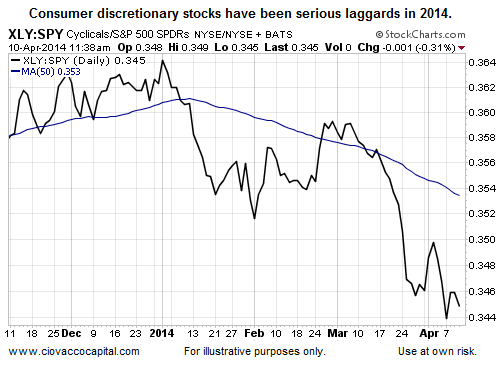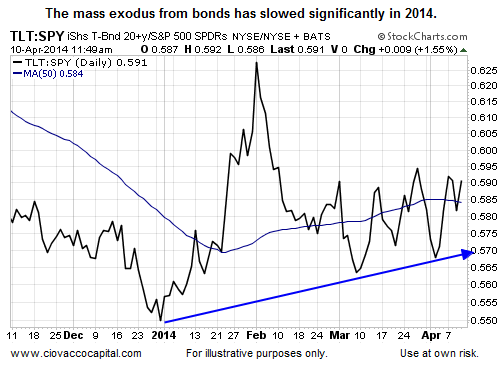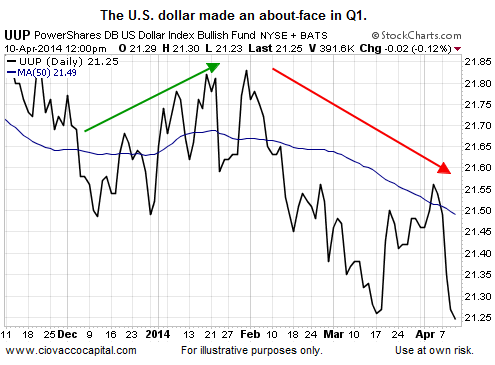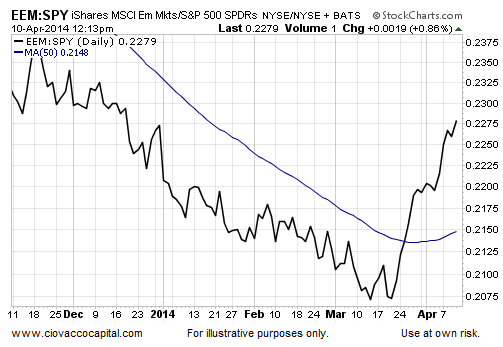The consumer discretionary ETF (ARCA:XLY) holds many common brands, such as Walt Disney Company (NYSE:DIS), Starbucks Corporation (NASDAQ:SBUX) and Ford Motor Company (NYSE:F). If you are concerned about your personal finances, you might logically decide to postpone that trip to Disney, cut back on the mocha lattes, and put off test driving a new Ford Focus. It seems as if some consumers have decided to stop off at McDonald's Corporation (NYSE:MCD) for their morning coffee in recent weeks (see chart below).

A tell-tale sign of a relatively fragile economy is weak pricing power. When companies are unsure about consumer demand, they are hesitant to increase prices. From The Street:
Prices for Arabica coffee increased over concerns about dry weather in Brazil which could cut production numbers. Starbucks may not pass that price increase to customers this year. In recent interviews CEO Howard Shultz said the company would hold off on any price increases. Some Starbucks locations reportedly lowered prices last week to combat McDonald’s (MCD_) free coffee promotion.
Expectations Toned Down On Rising Rates
Investors almost invariably are early when it comes to expectations for Fed rate hikes. Bonds are not the place to be if you believe interest rates are on the verge of rising rapidly (bonds fall in value in a rising rate environment). Therefore, if investors were becoming more confident the Fed was on the verge of an aggressive campaign to raise interest rates, the last thing they would want to do is flock to interest rate sensitive long-dated Treasury bonds (ARCA:TLT). The blue arrow below shows a short-term bias toward economic fear, rather than economic confidence.

We are also seeing increasing interest in dividend-oriented investments, such as REITS (ARCA:IYR) and the iShares Select Divided ETF (ARCA:DVY). Dividend-paying instruments, like bonds, tend to experience a drag from rising interest rates. Therefore, the interest in IYR and DVY aligns with the low-rate/weak economy theory.
Emerging Markets Point To Friendly Fed
When the Fed prints money to suppress interest rates, it tends to be a negative for the U.S. dollar. The dollar (UUP) has been weak of late, which supports expectations for relatively tame interest rates.

All things being equal, emerging markets (ARCA:EEM) economies prefer to see low rates in the United States and a weak greenback. EEM has responded.

The IMF recently voiced concerns about emerging markets debt, especially in a rising interest rate environment. If rates remain tamer than expected, some of those fears would be alleviated in the intermediate-term. From The New York Times:
As fears mount about emerging markets, American mutual fund investors with significant exposure to bonds issued by indebted companies in fast-growing economies may be at risk, the International Monetary Fund warned in a report published on Wednesday. In the Global Financial and Stability Report, I.M.F. economists highlighted the trouble spots on the financial horizon, noting the potential for growth to slow and interest rates to rise. As that happens, they estimated that problematic corporate loans could increase by as much as $750 billion and many companies may be pushed into default. That situation would hurt global investors, particularly mutual funds in the United States.
Investment Implications – Patience Is A Virtue
Our concern about adding emerging markets to our portfolios is the recent big picture trend toward increasing risk aversion. We are happy to look at all attractive opportunities, but we prefer to see more bullish stars line up before adding what can be a volatile EEM to our portfolio mix. We have been harping on clear evidence in recent weeks that pointed to a highly-indecisive market. The last 24 hours align with that theory. Wednesday, the S&P 500 was up 20 points; as of 12:30 p.m. EDT Thursday, it is down 22 points. Even though Wednesday’s rally was impressive at face value, we warned yesterday that not much had changed:
Wednesday’s sharp reaction to the Fed minutes and statements from Charles Evans did little to change the market’s risk-reward profile. Therefore, we made no changes to our current mix of stocks (SPY) and cash.
Economic doubts have impacted the emerging markets space this week. Reports from China dashed hopes for an imminent announcement of a major new form of stimulus. From Reuters:
Chinese Premier Li Keqiang ruled out major stimulus to fight short-term dips in growth, even as big falls in imports and exports data reinforced forecasts that the world’s second-largest economy has slowed notably at the start of 2014. Li stressed on Thursday that job creation was the government’ policy priority, telling an investment forum on the southern island of Hainan that it did not matter if growth came in a little below the official target of 7.5 percent. “We will not take, in response to momentary fluctuations in economic growth, short-term and forceful stimulus measures,” Li said in a speech.
The fear trade has gained some significant ground on emerging markets in recent sessions, which is indicative of increasing concerns about the strength of the never-ending global “recovery” (see chart below).

The most recent statements from China contrasted the “hopes for stimulus” story we referenced on April 3 from The New York Times:
China’s leaders are issuing increasingly clear signals that they plan another round of economic stimulus programs, as evidence accumulates that the economy is slowing more than expected this year.
The weight of the evidence is saying stocks (SPY) have greater downside risk today than they did in late 2014. Our market model has offset that risk by maintaining a very significant exposure to cash. If the indecisiveness breaks in the direction of “risk-off”, we will consider redeploying some cash into more conservative investments, such as bonds (AGG). We prefer to see how the remainder of Thursday and Friday play out before considering any chess moves. Wednesday’s bullish jawboning by the Fed is an example of how quickly an indecisive market can be influenced or flipped.
